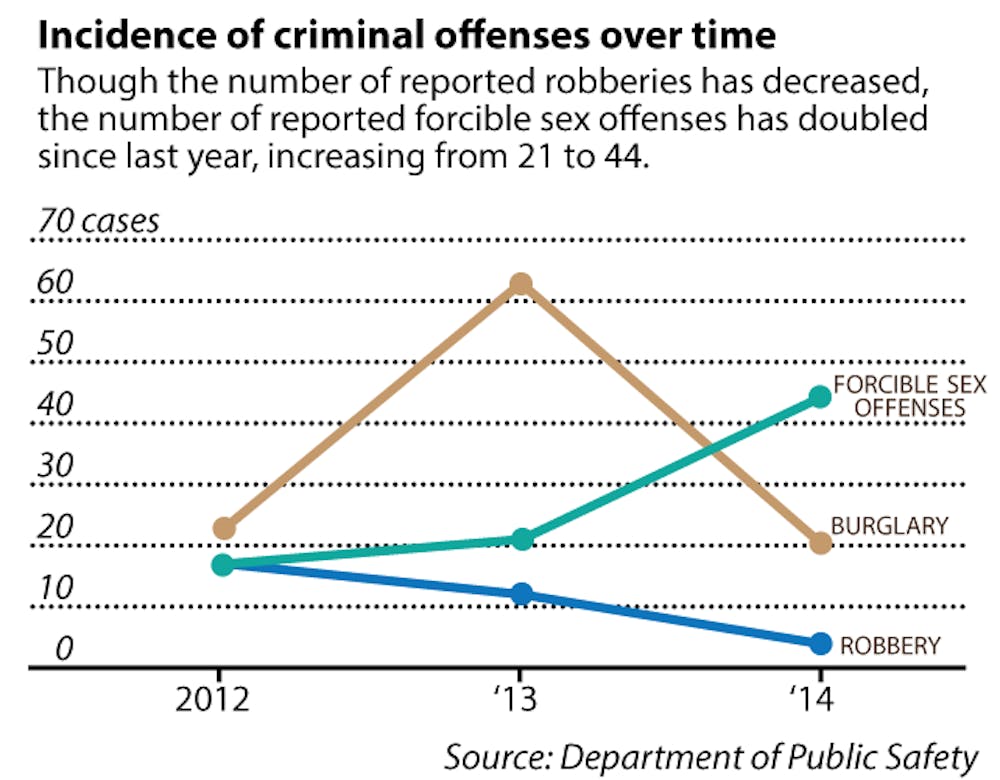The number of forcible sex offenses reported on campus in 2014 doubled since 2013 and nearly tripled since 2012, according to the University’s Annual Security Report released Wednesday.
Forty-three cases of forcible sex offenses were reported last year compared to 21 cases in 2013 and 16 in 2012.
Disciplinary referrals for drug violations on campus jumped from 27 in 2013 to 76 last year, following a major rise in referrals for liquor law violations from 2012 to 2013.
Burglary on campus decreased to 2012 levels after a spike in 2013, falling from 58 reported incidences to 20. Conversely, reports of burglary in District 9-2, where many students live off campus, rose markedly from 23 cases to 57.
Mark Porter, chief of police for the Department of Public Safety, attributed the increase in sexual offenses reported to improved education and greater student empowerment.
The report’s attention to resources for reporting and preventing sexual assault echoes Porter’s reasoning. The report stresses the importance of bystander intervention and explicitly dissects consent, coercion and incapacitation.
For instance, the report defines consent as “an affirmative and willing agreement” to engage in sexual conduct that requires “outward demonstration” via words or actions. It also emphasizes that neither silence nor passivity constitutes consent, that consent can be revoked at any time and that prior consent does not indicate future consent.
The report states that this understanding of consent or its absence will be seriously considered throughout the disciplinary process.
Reports produced by the Task Force on Sexual Assault and campus discussions on the subject over the past two years have likely encouraged more students to report sexual misconduct.
Despite the increase in reporting, Porter said the data still does not reflect all sexual offenses that have occurred.
The spike in referrals for drug violations can be attributed to a surge in the number of room searches over the past year, said Paul Shanley, deputy chief of police for DPS. Additional health and safety inspections for potential fire safety hazards have also discovered more drugs in dorm rooms than in previous years, he said.
Robbery around campus also dropped to four cases in 2014 from 12 in 2013.
Porter attributed the decreases in burglary and violent robbery around campus to education, including better distribution of information about room theft and property registration.
Students’ use of the Brown University Shuttle and SafeWalk program, along with the “yellow jackets” stationed strategically around campus and the increased visibility of DPS and Providence Police officers, have also likely contributed to the decrease in robbery, Shanley said.
Further east of College Hill, incidents of burglary rose notably in various districts of Mount Hope. Burglary nearly doubled in District 8-1 from 47 cases in 2013 to 88 last year.
Incidents of domestic violence in District 8-2 also jumped to 14 in the last year from zero in 2013, while reports of domestic violence increased slightly from zero to three on College Hill. Aggravated assault rose in Mount Hope from four in 2013 to 14 last year.
Reports of most other violent and nonviolent crimes, including homicide, motor vehicle theft, drug violations, hate crimes and arson remained consistent across districts. The report’s data is limited to the East Side of Providence.
But the report’s geographic limitations may do a disservice to the Brown community by enhancing the exclusivity of College Hill, said Stefano Bloch, a postdoctoral fellow in urban studies who teaches URBN 1230: “Crime and the City.”
The restricted data of the report “creates a city within a city” and makes the East Side “a privileged island,” Bloch said. If the report had included crime statistics from the West Side of Providence, overall crime would appear to be much higher, he said, adding that the East Side is much safer than other areas of the city.
Bloch also said crime rates have deceased consistently across the country since the 1990s. As in other cities, crime has diminished in Providence due to cultural, economic and spatial alterations, such as gentrification, he said. Attributing lower crime rates to better police work would represent a “narrow” and “too convenient” perspective, he added.
Ultimately, Bloch considers spikes in reported crime to be positive in nature. Bloch said a rise in statistics is “indicative of conversation,” sensitivity to crime and a more open discussion of crimes that would otherwise remain in the shadows, such as the sexual offenses reported last year.
— With additional reporting by Taneil Ruffin





